BMC Software Bundle
Can BMC Software Thrive in the Evolving IT Landscape?
The IT management software industry is undergoing a dramatic transformation, and BMC Software SWOT Analysis is at the forefront of this change. In a bold move to capitalize on this evolution, BMC Software announced its strategic split into two independent companies, BMC and BMC Helix, in late 2024, with full operation expected in early 2025. This restructuring, following impressive ARR growth, signals a commitment to adapting and excelling in the dynamic market.
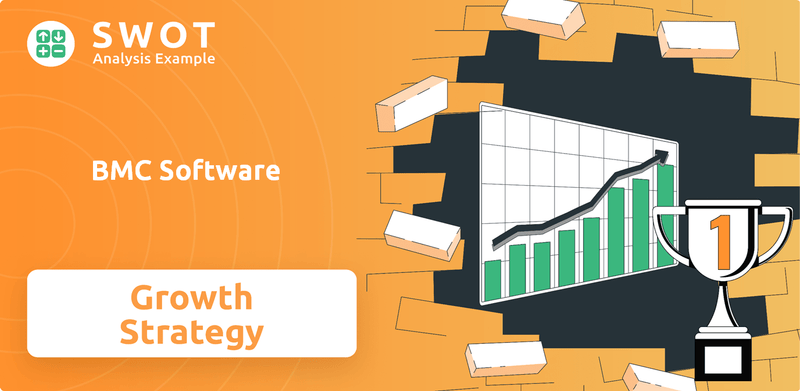
This strategic shift by the Software Company, aims to enhance product offerings and expand into new markets. With a strong foundation built over decades, including a vast customer base and industry expertise, BMC Software is poised for significant growth. This exploration will provide a comprehensive overview of BMC's plans, including its innovation strategy and financial outlook, while also addressing potential risks and opportunities in the IT Management sector.
How Is BMC Software Expanding Its Reach?
The growth strategy of BMC Software is heavily influenced by its expansion initiatives, especially the strategic decision to split into two separate entities by early 2025. This split is designed to accelerate growth and innovation by allowing each company to concentrate on specialized market segments. The core BMC entity will continue to focus on Intelligent Z Optimization and Transformation (IZOT) and Digital Business Automation (DBA), catering to hybrid IT environments, including mainframe and distributed systems.
BMC Helix, on the other hand, will focus on Digital Service and Operations Management (DSOM), utilizing AI-driven capabilities to grow its market share in IT operations management. This move is aimed at enabling faster innovation and delivering greater customer value in their respective areas. This strategic realignment is a key element of BMC Software's business development strategy, positioning it for future growth in a rapidly evolving market. For more insights, you can explore the details on Owners & Shareholders of BMC Software.
In the realm of mergers and acquisitions, BMC Software has been active. The most recent acquisition was Netreo in April 2024. Netreo, a provider of smart and secure IT network and application monitoring solutions, was acquired to enhance the BMC Helix platform with its network performance monitoring and diagnostics (NPM&D) capabilities. This acquisition aims to provide customers with a full-stack, open observability, and AIOps solution, offering comprehensive visibility into business operations across infrastructure, networks, and applications.
The split into two independent entities by early 2025 is a pivotal move. This allows each company to focus on specialized market segments, accelerating innovation and growth. The core BMC entity will concentrate on IZOT and DBA, while BMC Helix will focus on DSOM.
Acquired in April 2024, Netreo brings network performance monitoring and diagnostics capabilities to the BMC Helix platform. This enhances the platform with a full-stack, open observability, and AIOps solution. This acquisition aligns with BMC's strategy to provide comprehensive solutions.
Partnerships are crucial for expanding reach and accessing new markets. The collaboration with Hitachi Vantara in February 2025 aims to transform mainframe innovation. These partnerships are key to delivering innovative solutions and driving customer value.
BMC's strategy emphasizes staying ahead of industry changes, particularly the shift towards cloud-based solutions and the increasing focus on automation and AI. This focus is evident in acquisitions like Model9 and the integration of AI-driven capabilities in BMC Helix.
BMC Software's expansion strategy involves a combination of strategic splits, acquisitions, and partnerships to drive growth. These initiatives are designed to enhance product offerings and adapt to industry trends, particularly in cloud computing and AI-driven solutions.
- Strategic Split: Divides the company into two entities to focus on specific market segments.
- Acquisitions: Enhances product offerings and capabilities, such as the Netreo acquisition for network monitoring.
- Partnerships: Collaborations like the one with Hitachi Vantara to drive innovation and expand market reach.
- Innovation: Focus on cloud-based solutions and AI-driven capabilities to stay competitive.
BMC Software SWOT Analysis
- Complete SWOT Breakdown
- Fully Customizable
- Editable in Excel & Word
- Professional Formatting
- Investor-Ready Format
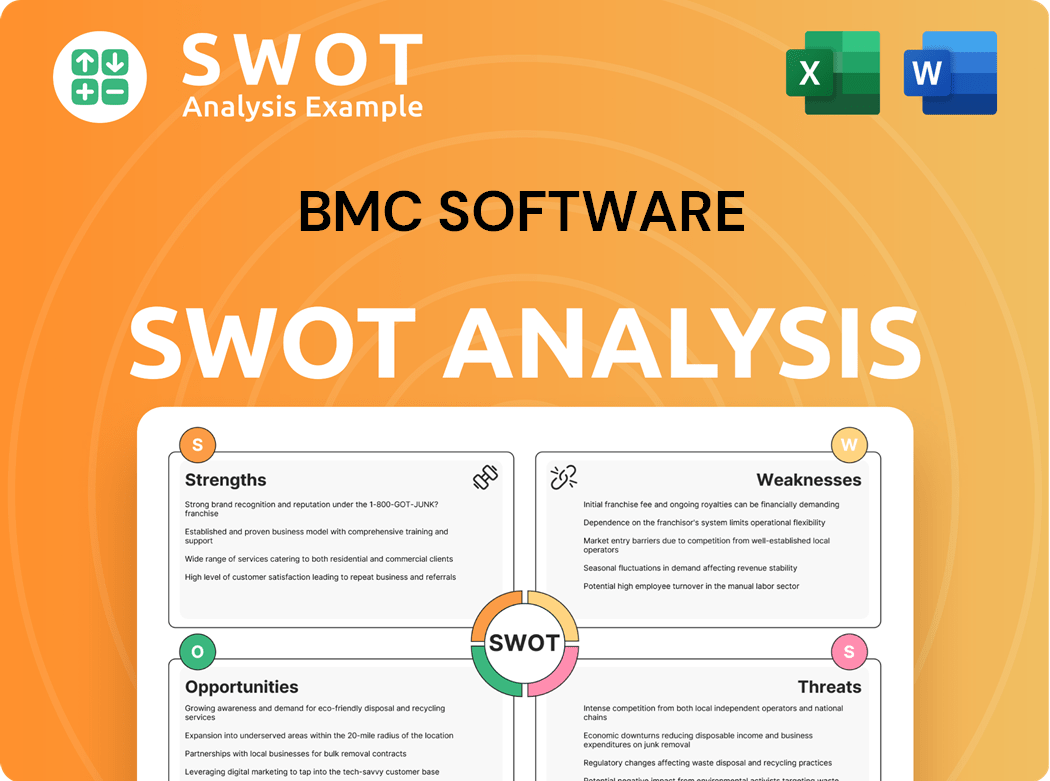
How Does BMC Software Invest in Innovation?
The innovation and technology strategy of BMC Software centers on leveraging technology, particularly artificial intelligence (AI), to drive sustained growth. The company's strategic direction, including the early 2025 split into BMC and BMC Helix, is designed to accelerate AI-driven innovation and meet evolving market demands. This approach emphasizes the integration of generative AI within existing product offerings, allowing customers to incorporate their own large language models.
BMC's focus is on enhancing its product portfolio with AI capabilities. This includes solutions like BMC HelixGPT, which generates summaries for vulnerabilities, and automating recovery tasks with BMC AMI solutions. The company's efforts extend to supporting hybrid cloud environments and simplifying digital service and infrastructure management through AI.
The company's commitment to research and development (R&D) is evident in the continuous improvement of platforms like BMC Helix AIOps. This platform uses machine learning to address IT issues proactively, reducing downtime and improving operational efficiency. BMC's Autonomous Digital Enterprise (ADE) framework further demonstrates its dedication to utilizing AI/ML capabilities to help businesses become more agile and customer-centric.
BMC Software is focused on integrating generative AI into its product portfolio, rather than offering a single AI platform. This allows customers to integrate their own large language models. This approach is exemplified by BMC HelixGPT, which generates summaries for vulnerabilities.
BMC Helix, as a separate entity, concentrates on AI-driven Digital Service and Operations Management (DSOM). This focus positions BMC Helix to lead in the rapidly expanding DSOM market. The strategic split aims to better address market demands and accelerate AI-driven innovation.
BMC invests heavily in R&D to enhance platforms like BMC Helix AIOps, which uses machine learning. This investment results in proactive IT issue resolution, reduced downtime, and improved operational efficiency. The company's ADE framework showcases its commitment to AI/ML.
BMC supports hybrid cloud environments and uses AI to simplify digital service and infrastructure management. This includes solutions that feed real-time IMS data into analytics engines and SIEM platforms. These enhancements improve decision-making and system reliability.
BMC's Control-M and BMC Helix workflows are used for automating issue resolution and process automation. These tools facilitate managed file transfers and streamline ITSM and ITOM workflows. This automation improves efficiency across various IT operations.
The company aims to drive business value faster through AI, including generative AI, via research, customer collaboration, and development. This approach helps businesses run and reinvent themselves with agility and customer-centricity. The goal is to deliver value rapidly.
BMC Software's growth strategy heavily relies on innovation and technology, particularly in AI and digital transformation. This includes a focus on AI-driven solutions and enhancing existing products with generative AI capabilities. The company's investments in R&D and its Autonomous Digital Enterprise (ADE) framework demonstrate a commitment to leveraging AI/ML to improve business agility and customer-centricity. To understand the company's foundation, a Brief History of BMC Software can be helpful.
- AI Integration: Gradual infusion of generative AI into the product portfolio.
- BMC Helix Focus: Dedicated to AI-driven Digital Service and Operations Management (DSOM).
- R&D Investments: Continuous enhancement of platforms like BMC Helix AIOps.
- Hybrid Cloud Support: Solutions to manage digital services and infrastructure complexities.
BMC Software PESTLE Analysis
- Covers All 6 PESTLE Categories
- No Research Needed – Save Hours of Work
- Built by Experts, Trusted by Consultants
- Instant Download, Ready to Use
- 100% Editable, Fully Customizable
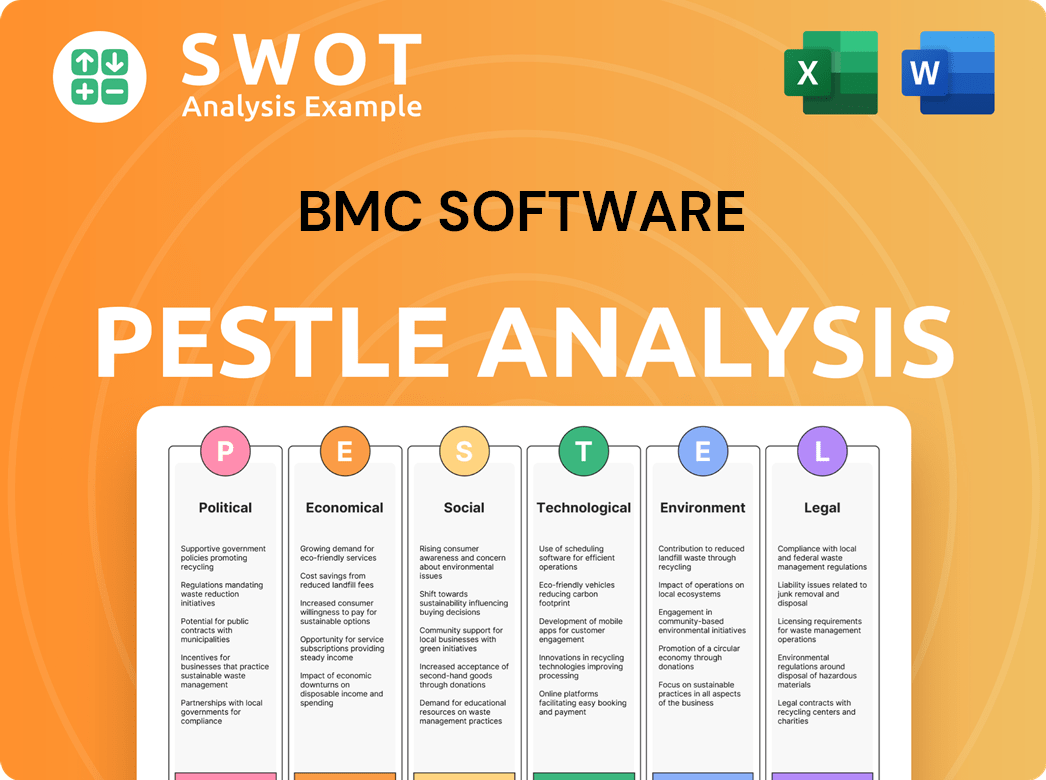
What Is BMC Software’s Growth Forecast?
The financial outlook for BMC Software demonstrates a positive trajectory, driven by solid revenue growth and strategic initiatives. The company's performance in fiscal year 2024 reflects this, with a 3.5% increase in revenue. This growth is supported by strong product bookings and an increase in annual recurring revenue (ARR), which grew by 13.4% and 7.4% respectively. BMC Software's shift towards a subscription revenue model is also a key factor, with subscription sales accounting for nearly 60% of total sales in fiscal 2024.
Looking ahead, the company's financial health is expected to remain robust. S&P Global Ratings anticipates a revenue increase of approximately 4.1% for fiscal year 2025, fueled by the continued momentum in bookings and ARR. This growth is projected to support a return to S&P Global Ratings-adjusted EBITDA margins above 40%. Although cash generation saw a slight dip in fiscal 2024 due to higher interest expenses, profitability remains a key strength. Both EBITDA margin and cash generation are expected to rebound to historical levels as revenue continues to grow.
The company's financial performance and strategic decisions are also influenced by the competitive landscape. For an overview of the competitive environment, consider reading about the Competitors Landscape of BMC Software. This split is designed to boost growth in specific markets.
BMC Software reported a 3.5% revenue increase in fiscal year 2024. This growth was driven by improvements in product bookings and ARR.
Subscription sales represented nearly 60% of total sales in fiscal 2024. This shift towards a subscription model indicates a strategic focus on recurring revenue.
S&P Global Ratings forecasts a revenue increase of approximately 4.1% for fiscal year 2025. This growth is expected to support a gradual return to adjusted EBITDA margins greater than 40%.
Profitability remains a credit strength, and both EBITDA margin and cash generation are anticipated to return to historical levels. S&P Global Ratings projects leverage to decline to under 8x in fiscal 2025.
The company's financial strength has enabled the strategic decision to split into two independent companies, BMC and BMC Helix. About two-thirds of the current company's $2.3 billion in revenue will be allocated to the new BMC business, with the remainder going to BMC Helix.
While BMC had confidentially filed for an IPO in February 2023, with analysts expecting a listing in 2024, the company also considered a sale if the IPO market did not fully recover.
BMC Software Business Model Canvas
- Complete 9-Block Business Model Canvas
- Effortlessly Communicate Your Business Strategy
- Investor-Ready BMC Format
- 100% Editable and Customizable
- Clear and Structured Layout
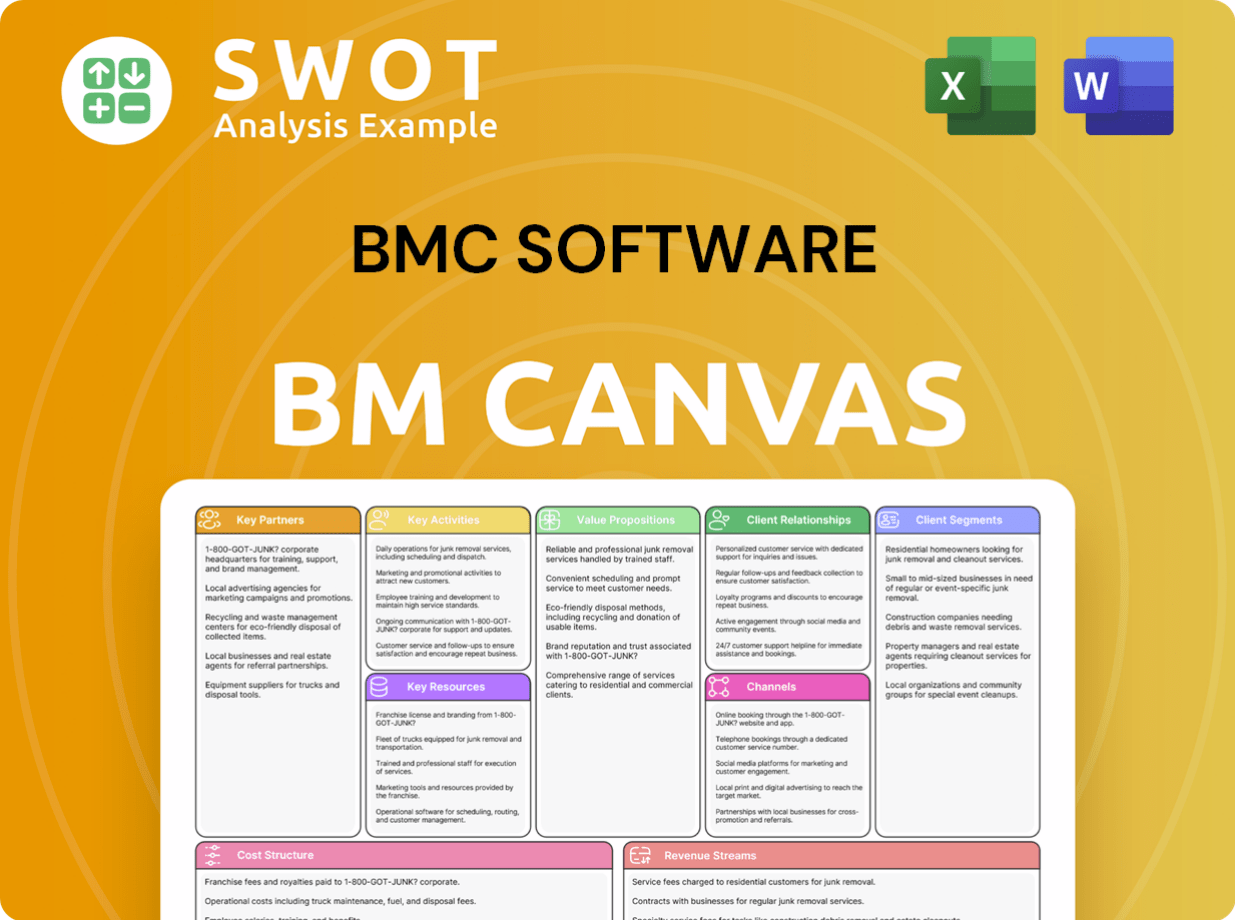
What Risks Could Slow BMC Software’s Growth?
The path forward for BMC Software, like any major Software Company, is fraught with potential risks and obstacles. Navigating the competitive landscape, adapting to rapid technological shifts, and ensuring regulatory compliance are critical challenges. These factors can significantly impact BMC's Growth Strategy and its overall BMC Future.
BMC Software must contend with fierce competition from industry giants and innovative startups. Furthermore, the company faces the ongoing challenge of technological disruption, requiring continuous adaptation and innovation to stay relevant. Successfully managing these risks is essential for sustainable growth.
Internal resource constraints, coupled with the complexities of a strategic split, add to the risks. Maintaining operational continuity and ensuring customer satisfaction during such transitions are crucial for BMC Software's success. The company's ability to mitigate these risks will define its trajectory.
BMC Software faces intense competition from established players like IBM, ServiceNow, and Broadcom. ServiceNow is a particularly strong competitor in the IT Service Management (ITSM) space. Competition will likely intensify as rivals focus on mainframe optimization and AI-driven service management.
The IT industry's constant evolution poses a significant risk. The increasing adoption of cloud-based solutions and advancements in AI and automation require BMC Software to innovate continuously. The company must adapt quickly to maintain its market position.
A critical vulnerability (CVE-2024-54085) in AMI's MegaRAC Baseboard Management Controller (BMC) software, affecting numerous hardware vendors, highlights supply chain risks. This flaw, disclosed in March 2025, allows for remote authentication bypass, potentially leading to serious security breaches. Implementing patches requires downtime, complicating remediation.
New regulations, such as Europe's Digital Operational Resilience Act (DORA), effective January 2025, and New York State's new mandates later in 2025, increase the emphasis on data security and recoverability. Non-compliance with cybersecurity and data protection laws can lead to substantial fines. The financial sector, a key client base, faces increasing regulatory scrutiny.
Internal resource constraints and the complexities of the company's strategic split, expected to be fully operational in early 2025, pose risks. Maintaining operational continuity and ensuring customers experience the benefits of the transformation, rather than disruption, is crucial. Successfully managing this transition is key.
The strategic split expected in early 2025 introduces operational complexities. Ensuring a smooth transition for customers and maintaining business continuity during this period is essential. The success of this split will significantly influence BMC's future.
BMC Software is leveraging solutions like BMC HelixGPT to understand and prioritize vulnerabilities. The company is also focusing on continuous innovation, strategic partnerships, and a customer-centric approach. These strategies aim to address challenges and ensure long-term success. For further insights into BMC's approach, explore the Marketing Strategy of BMC Software.
With the implementation of DORA in January 2025, and similar mandates in New York, BMC Software must prioritize tools and processes that ensure compliance. The financial sector, a major client, requires robust solutions for data security and recoverability. A bank achieved 100% compliance with primary digital operational resilience regulations in January 2025 using BMC Helix.
BMC Software Porter's Five Forces Analysis
- Covers All 5 Competitive Forces in Detail
- Structured for Consultants, Students, and Founders
- 100% Editable in Microsoft Word & Excel
- Instant Digital Download – Use Immediately
- Compatible with Mac & PC – Fully Unlocked
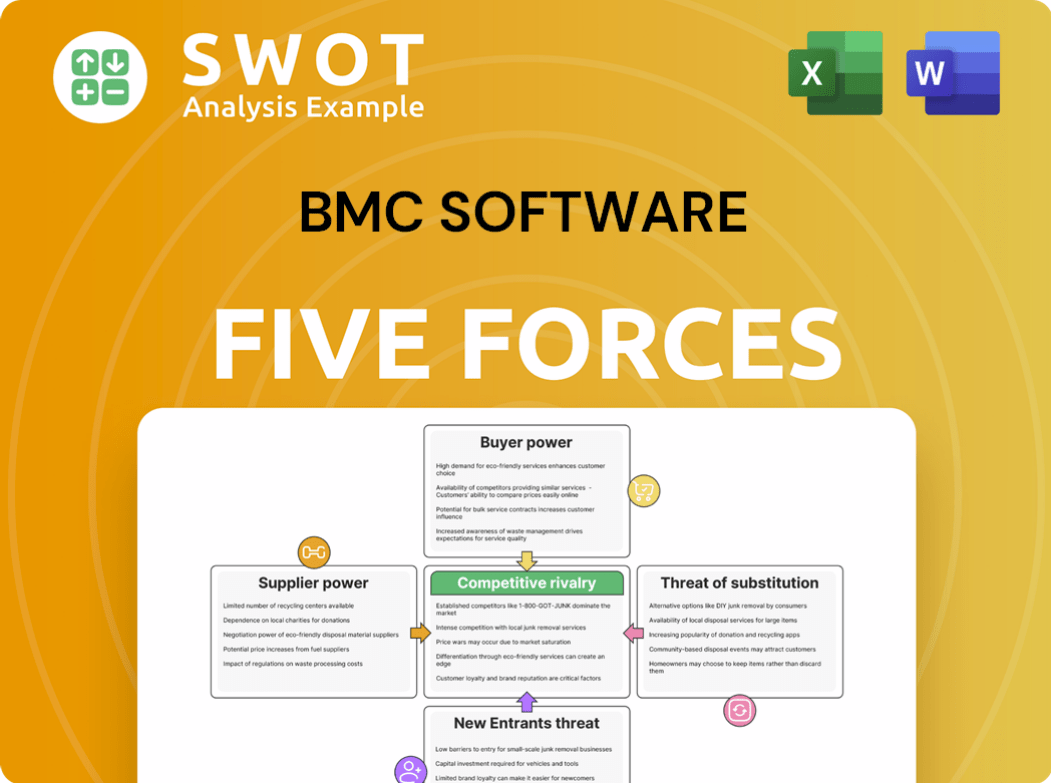
Related Blogs
- What are Mission Vision & Core Values of BMC Software Company?
- What is Competitive Landscape of BMC Software Company?
- How Does BMC Software Company Work?
- What is Sales and Marketing Strategy of BMC Software Company?
- What is Brief History of BMC Software Company?
- Who Owns BMC Software Company?
- What is Customer Demographics and Target Market of BMC Software Company?
Disclaimer
All information, articles, and product details provided on this website are for general informational and educational purposes only. We do not claim any ownership over, nor do we intend to infringe upon, any trademarks, copyrights, logos, brand names, or other intellectual property mentioned or depicted on this site. Such intellectual property remains the property of its respective owners, and any references here are made solely for identification or informational purposes, without implying any affiliation, endorsement, or partnership.
We make no representations or warranties, express or implied, regarding the accuracy, completeness, or suitability of any content or products presented. Nothing on this website should be construed as legal, tax, investment, financial, medical, or other professional advice. In addition, no part of this site—including articles or product references—constitutes a solicitation, recommendation, endorsement, advertisement, or offer to buy or sell any securities, franchises, or other financial instruments, particularly in jurisdictions where such activity would be unlawful.
All content is of a general nature and may not address the specific circumstances of any individual or entity. It is not a substitute for professional advice or services. Any actions you take based on the information provided here are strictly at your own risk. You accept full responsibility for any decisions or outcomes arising from your use of this website and agree to release us from any liability in connection with your use of, or reliance upon, the content or products found herein.